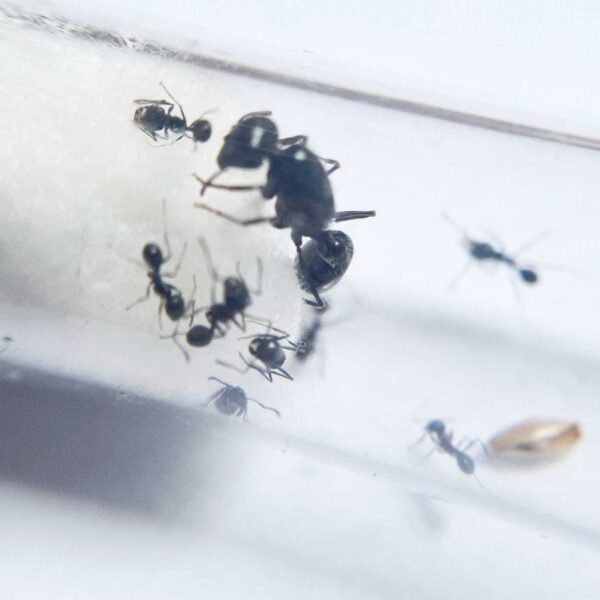Tetraponera rufonigra: A Species of Aggressive and Territorial Ants
Tetraponera rufonigra is a species known for its aggressive nature and territorial behavior. This ant species is fiercely protective of its territory and nest, and will sting multiple times if threatened. The pain from their sting can last for several hours. They have excellent eyesight and their movements are sharp and chaotic.
Colony Information
Colony type: Polygyny
Colony size: Up to 500 workers
Development rate: Medium
Size
Queen: 12-16mm
Workers: 10-12mm
Color: Black head and belly, orange-red to dark red chest
Nutrition
Tetraponera rufonigra colonies primarily feed on a diet of food insects such as cockroaches and crickets. They also consume syrup made from a mixture of water and honey. The recommended ratio for syrup is 4 parts water to 1 part honey. Additionally, they can also feed on various fruits.
Arena Conditions
Humidity for the arena should be maintained at a range of 30-50%. For the nests, a higher humidity level of 50-70% is recommended. The ideal temperature for the arena is between 22-28°C, while the nests should be kept at a slightly lower temperature range of 20-24°C.
Recommended Nest Types
When breeding Tetraponera rufonigra, it is suggested to use nests made of acrylic, gypsum, or aerated concrete. These materials provide a suitable environment for the colony’s development and allow for easy observation of the ants’ activities.
Overview of Tetraponera rufonigra
Tetraponera rufonigra is a fascinating ant species known for its aggressive behavior and territorial nature. This species has a polygynous colony structure, meaning it can have multiple queens coexisting within a single colony. With a colony size of up to 500 workers, they are highly organized and efficient in their tasks.
The size of the queen ranges from 12 to 16mm, while the workers are slightly smaller, measuring between 10 and 12mm. The coloration of this ant species is striking, with the head and belly being black, and the chest displaying vibrant hues ranging from orange-red to dark red.
In terms of nutrition, Tetraponera rufonigra primarily feeds on a diet of food insects such as cockroaches and crickets. This species is also known to consume syrup made from a mixture of water and honey. It is advised to maintain a ratio of 4 parts water to 1 part honey for the syrup. To provide a varied diet, feeding them with different types of fruits is also recommended.
Creating the ideal environment for Tetraponera rufonigra is crucial for their well-being. The humidity levels in the arena should be maintained at 30-50%, while the nests require a higher humidity range of 50-70%. When it comes to temperature, the arena should be kept between 22-28°C, while the nests should be slightly cooler at 20-24°C. These conditions ensure the ants’ optimal growth and activity.
One notable characteristic of Tetraponera rufonigra is their aggressiveness and territorial behavior. They are fierce defenders of their nest and territory, and their sting can cause significant pain that lasts for several hours. Their keen eyesight and sharp, chaotic movements contribute to their ability to detect and respond to threats effectively.
For breeding purposes, it is recommended to provide nests made of acrylic, gypsum, or aerated concrete. These materials offer suitable conditions for the colony’s development and allow for easy observation of the ants’ activities. Proper nest selection is crucial to support the growth and productivity of the Tetraponera rufonigra colony.
In conclusion, Tetraponera rufonigra is an intriguing ant species with unique characteristics. Understanding their colony structure, nutritional needs, and ideal environments is essential for creating a successful and thriving colony. By providing the appropriate conditions and observing their fascinating behavior, ant enthusiasts can appreciate the beauty and complexity of these remarkable insects.
















Reviews
There are no reviews yet.